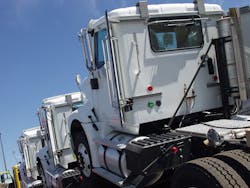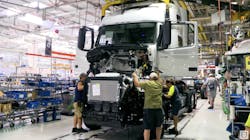With new trucks scarce, fleets alter course to address tractor needs
The COVID-19 and post-pandemic period in trucking has tested fleets in several ways but one significantly: equipment. During an extended period now, OEMs have been constrained, mostly because of a shabby supply chain and component and material shortages, from delivering tractors and to a lesser degree trailers.
Where this has been felt most is with freight haulers themselves, which have adopted a variety of strategies such as reducing their new-truck orders, canceling orders altogether, keeping their used equipment and ordering even more preowned gear, or even reducing the size of their operations to cope.
They’ve redefined the words “replacement cycle” in the last two to three years.
The year is young, but the hope for 2023 is there will be more consistent fulfillment of new-tractor orders. New trailers are flowing to fleets better, according to several that FleetOwner interviewed, but delivery of new trucks is rarer, forcing carriers to consider other options. There is more nuance in the market, others said, given the recent freight volume slowdown, so less equipment is going to be needed.
See also: Freight markets remain in a lull ahead of projected upturn
This dynamic has come into play at Skyline Transportation, a Knoxville, Tennessee, asset-based fleet of about 130 power units that services the eastern U.S. with truckload services, dedicated, specialized hauling such as hazardous materials, and expedited. The fleet’s president, Jeff Reed, noted that the unnamed OEM from which Skyline purchases its new trucks has limited its deliveries to 50% of those units the carrier ordered, “so there’s not much improvement there.”
“We could obtain the other 50% of trucks we need from other OEMs, but in our experience the pricing is much higher than our preferred brand, so we chose not to order,” Reed added in an email exchange with FleetOwner.
Delays, however, are getting better, he added. “Production schedules and delivery ETAs are more accurate. In 2021, we saw delays of nine months or more from the original scheduled delivery, but now we are seeing delivery within 30 days of the original schedule,” Reed said.
Skyline is one fleet that is dealing with equipment challenges with a holistic approach. The fleet, Reed said, is only able to replace half of the old equipment with new, so he’s anticipating reducing the size of his fleet by 10% to 15% as a result, “which is fine given the current drop in freight volumes.”
Backlogs still sky high, but experts say they will ease
“There’s still a line to get trucks,” said Kenny Vieth, the veteran trucking industry equipment observer who is president and senior analyst at ACT Research, which tracks OEM backlogs, fleet cancellations, and the market for all classes of commercial tractors and their trailers.
“In this industry, while having supply chain difficulties in 2021 and most of 2022, there was a willingness on the part of trucking companies to add to their fleets, and they were unable to do so. The industry came into 2023 with pent-up demand, highlighted by a net order record in September, when OEMs were opening up their books.”
Class 8 truck orders among the major truck OEMs—Freightliner (Daimler), Kenworth and Peterbilt (Paccar), International (Navistar), and Volvo and Mack (Volvo Trucks)—did soar to a single-month record in September 2022 to 53,700 units, ACT reported, and rival industry data aggregator FTR Transportation Intelligence had them even higher that month at 56,500, or 169% higher than the previous month and more than 102% year-over-year. They have abated since, including to 18,400 in January 2023, according to ACT, but all the orders added to OEM backlogs, which constitute orders received by the manufacturers that wait to be fulfilled.
See also: Class 8 orders rise for first time in months
How successfully OEMs turn backlogs into fulfillment to dealers or directly to carriers is the real question for fleets that are trying to solve their new and used equipment and fleet-size dilemma. That has been a central problem, but in an interview with FleetOwner, Vieth sounded an optimistic tone about backlogs coming down and new-truck availability coming up with improved production in 2023.
Vieth said ACT data shows that collectively all OEMs had a backlog of 243,790 new units at the end 2022 and that the backlog-to-build ratio stood around eight months.
“We shouldn’t see the cratering of backlog [in 2023] that we saw by the end of 2019," he added. "But backlog won’t be as high as December of 2022. An improved level of production has been occurring since about August of 2022. While there are some constraints and challenges in the supply chain, most of the surprises that were biting the industry are largely in the rearview mirror.”
Vieth voiced more optimism in ACT’s latest release of its North American Commercial Vehicle Outlook, which says despite a stumbling freight picture, higher financing costs, and increasingly restrictive credit availability, ACT as an organization continues to see healthy sales and build trends for Class 8s this year. Pent-up demand and still elevated carrier profits in early 2023 continue to provide a supportive environment for new equipment, according to the outlook.
See also: Traton CEO: ‘We need to somewhere expect that price increases cannot continue’
“The industry enters 2023 with a fair amount of visibility, thanks to a robust backlog,” Vieth added in that report. “While down year-over-year, the December-ending Class 8 backlog represents the fourth highest year-end backlog on record. With this as context, our call for strong production in 2023 is hardly a stretch. That said, we do expect softening, as lower freight volumes and rates, higher costs, improved equipment availability, and the gradual exhausting of pent-up demand begin to exert downward demand pressure.”
Class 8 sales in January were relatively weak but were unfased by higher interest rates, ACT reported on Jan. 17, saying in its State of the Industry Classes 5-8 report that “it remains to be seen whether this represented a pause after robust year-end orders, or the beginning of a more broad-based pullback in demand." The monthly report looks at current production, sales, and general state of the on-road heavy- and medium-duty commercial vehicle markets in North America.
In January, heavy-duty retail sales rose 29% year-over-year but were down compared to how 2022 ended, said Eric Crawford, ACT’s VP and senior analyst. He added that retail sales seem to be unfazed by "higher interest rates, as pent-up demand remains, for now. We expect this dynamic to shift in [the second half of 2023] as the Fed continues its aggressive push to subdue inflation.”
Cancellations still low, despite backlogs
Order reductions and cancellations can be how a lot of fleets react when OEMs can’t deliver on time. So far, that’s not happening en masse, ACT’s Vieth said. From April to December, the cancellation rate was below 1% of the backlog in each of those months, which he called unprecedented and “gets to the level of demand, the level of carrier profitability, and it goes to the strength of the freight economy.”
But, he added, cancellations will go up because the current weakness in the spot freight market will eat into carrier profits, reducing their ability to fund new equipment, regardless of whether fleets actually can get the trucks. By the second half of 2023, backlogs will go down because OEMs “will add a lot of trucks into a freight market that is clearly slowing down. As strong as demand is right now, profitability is a question. Spot rates have a way of pulling down contract rates. Margins will get squeezed for carriers.”
During his own interview with FleetOwner, Fisher said Jetco does carry out other strategies to manage its equipment inventory and ensure more timely truck deliveries than the current environment is allowing. Those strategies include breaking from brand loyalty, he said, adding that while Freightliner is Jetco’s usual nameplate, the carrier also is buying Kenworth Class 8s this year.
Unlike many fleets, however, accepting different specs on its on-road vehicles currently isn’t usually one of Jetco's strategies, Fisher added, at least when it comes to engines. “We were approached yesterday if we’d accept them with different engines," he said, "but we didn’t want that.”
See also: ACT: December used truck sales increase 20% over November
Overall fleet turnover at Jetco is not high, he said. “We [ordered] a group of four trucks last year—only got three, so we're still waiting on one. Gradual turnover, not high.”
Jetco does pay closer attention to used trucks—both in monitoring the hours of operation on its own tractors, “being very stingy about what trucks we want to retire or sell,” and in what might be available on a market where preowned sale prices still are inflated. “We will buy used equipment, but now we’re looking at hours, not going over a certain number of hours, stuff that we didn’t do before. Looking at the year and hours run.” Fisher described monitoring hours of operation as Jetco’s primary metric for trucks, both its own and used vehicles it might seek to consider purchasing.
Another smaller Houston-area fleet, Clark Freight Lines of Pasadena, Texas, also is taking a measured approach to equipment management with new-truck deliveries so constrained but is still able to stick to its usual replacement cycle, Clark Freight’s president, Danny Schnautz, told FleetOwner. Clark Freight owns a fleet of 24 power units made up of Kenworths and Macks and relies on 140 owner-operators to run company-owned dry vans, flatbeds, and intermodal chassis out of four terminals, he said, and the carrier has a heavy intermodal presence in and around the Port of Houston.
Schnautz added: "We’re generally running our used trucks a little bit longer. We’ve had to have a lot more communication with the dealer, and we’ve had some nail-biting. We try to keep our trucks under warranty, but we’ve had to run some trucks out of warranty. We want to keep new trucks for our drivers."
With used trucks a fallback for fleets, prices stay high
Vieth said ACT’s data shows that prices of preowned commercial vehicles are remaining elevated, but not nearly as sky-high as their apparent peak last April of about $102,000. According to another analyst, J.D. Power’s Chris Visser, a used Class 8 in its prime, 3 years old with typical mileage (about 400,000 miles), cost as much as $165,000 to $175,000 retail between March through May 2022.
Vieth said the average retail price of a used truck was down to $80,400 by December 2022. “Historically, the average used truck sale price over the course of the last decade was right around $50,000. It’s still elevated. Inflation plus a constrained new-truck market led to those price increases. And a new one is significantly more than it was prior to the pandemic,” he said.
See also: Trailer orders return to ‘normal;' backlog stretches to 2024
According to the release of another of ACT’s reports, the State of the Industry: U.S. Classes 3-8 Used Trucks, used Class 8 retail volumes, or same dealer sales, increased 16% in December over November. Average mileage was down 4% compared to November, with average price and age down 2% and 3%, respectively. Class 8 used-truck market sales for 2022 were 245,000 units, down from 265,000 in 2021.
Steve Tam, VP at ACT, added: “While the economy and freight markets are slowing, effectively cooling used-truck demand, there are many used-truck buyers who have been forced to hold onto their trucks beyond their expiration dates” because of constrained new-truck deliveries.
About the Author
Scott Achelpohl
Managing Editor
Scott Achelpohl is a former FleetOwner managing editor who wrote for the publication from 2021 to 2023. Since 2023, he has served as managing editor of Endeavor Business Media's Smart Industry, a FleetOwner affiliate.




